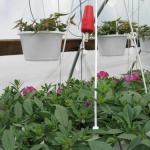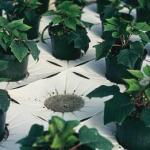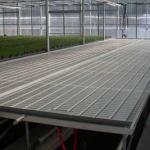Irrigation Systems
Greenhouse crops are irrigated by means of applying water to the media surface through drip tubes or tapes, by hand using a hose, overhead sprinklers and booms or by applying water through the bottom of the container through subirrigation, or by using a combination of these delivery systems. Overhead sprinklers and hand watering have a tendency to "waste" water and also wet the foliage, which increases the potential for diseases and injury. Drip and subirrigation systems are the most efficient and provide greater control over the amount of water applied. Also, since the foliage does not become wet there is a reduced potential for diseases and injury.
Drip Irrigation
Drip irrigation can be a valuable tool for accurate growing medium moisture control. It also saves water and labor, and reduces the potential for groundwater pollution. Drip irrigation systems eliminate runoff of water missing the pot during overhead irrigation and the volume of water applied to the pot can be controlled. In theory it should be possible to greatly reduce or eliminate leaching from pots by simply turning the system off as container capacity is reached. Controlling drip systems with the use of a tensiometer placed in the growing medium to sense moisture tension (level) and a small computer programmed to turn the system on or off when preset moisture tensions are reached has been shown to reduce runoff from potted chrysanthemums and poinsettias to nearly zero.
Vegetable crops when grown in ground beds, bags or pots are commonly watered with drip tapes. Tubing is placed atop the ground or container or woven through the bags.
Water Trays and Saucers
In this system, water is applied to the surface and is collected under the container through collection trays or saucers Water trays and saucers, depending on their shape and spacing on the bench, can greatly reduce runoff and leaching by containing the water draining from pots and holding the water which misses the pot during overhead watering. They are inexpensive and reusable. Water which collects in them should be given adequate time to evaporate or be absorbed by the plant before further irrigation. Avoid tight plant spacing and poor ventilation to prevent disease problems when using this technique.
Subirrigation
Subirrigation systems, also know as zero runoff, are an environmentally responsibly alternative that conserves water and fertilizers. They are being installed by greenhouse growers to improve product quality, achieve more uniform growth and increase production efficiency.
In subirrigation systems, water and nutrient solution provided at the base of the container rises by capillary action through holes in the bottom and is absorbed by the growing media. These systems are adaptable to crops grown in pots or flats.
Advantages of subirrigation systems
- Water and nutrient solutions are contained and recycled
- Water and fertilizer usage decreases at least 50% over conventional systems
- Uniform watering of all containers
- Pot size and placement can be easily changed
- More vigorous plant growth
- Foliage remains dry
- Labor input is reduced
Examples of Subirrigation Systems
Capillary mat systems
In a capillary mat system the pots are set on a mat that is kept constantly wet with a nutrient solution. Several styles of fabric mats are available from ¼” to ½” thick. The pots take up the solution through holes in the bottom. The mat is places on a level bench over a layer of plastic. Water is supplied from drip tubes laid on top of the fabric.
To keep algae under control, a layer of perforated film plastic is sometimes placed over the top of the mat. Algicides are also used. Some growers turn the mat over when a new crop is started. Containers holding nutrient solution and piping should be enclosed in black plastic or painted black to eliminate light and algae formation.
Trough system
In this system, plastic or metal troughs are placed on existing benches or supported overhead from the greenhouse structure. The troughs are installed at a slight slope (3” to 6” per 100’) from one end to the other. Pots are spaced along the trough. Nutrient solution, supplied from spaghetti tubes, is pumped to the high end, flows past the base of the pots and is collected in a cross gutter at the low end. The solution returns to a storage tank under the benches or below ground to be recycled.
One advantage to this system over other ebb and flow systems
is the air circulation that occurs between the troughs. Another
is the ability to space the troughs for different size pots. Trough systems tend to be less expensive than bench systems and can be easily installed in existing greenhouses.
Ebb and flood benches and movable trays
This system uses 4’ to 6’ wide watertight benches or water-tight movable trays to contain the nutrient solution. The benches, usually of plastic or fiberglass construction are installed perfectly level to maintain a uniform depth of liquid. They can be installed as either fixed or movable depending on the crops to be grown. Channels in the bottom of the bench allow the water to distribute evenly and to drain rapidly when the water supply is shut off. This allows the bench top to dry reducing algae growth and disease potential.
In operation nutrient solution is pumped from a holding tank to a level of ¾” to 1” depth in the bench and held there for 10 minutes or long enough for the media in the container to absorb the solution. A valve is then opened and the liquid is quickly drained by gravity back into the tank. Low cost PVC pipe is used as it is not affected by the fertilizer in the water. A filter removes any solid matter. The holding tank, usually located in the floor below the benches should have a capacity for about ½ gallon/sq ft of bench area.
The nutrient solution is used over again but adjustments in pH and soluble salts may have to be made as water is added. Water treatment with chlorine, ultra violet (UV) light or ozone is used by some growers to prevent diseases. Control of the nutrients and flow can be manual or with a controller. Watering may be once or twice a week to several times a day depending on the weather and the size of the crop.
Flood Floors
Flooded floors work on the same principle and with the same equipment as ebb and flow benches. A watertight concrete is necessary for the floor surface and it must be installed as smooth as possible to avoid pockets. A laser transit is used to get a perfect slope, usually ¼” in 10’. A concrete contractor having experience with flood floor system should be hired. Berms may be installed at the post line in gutter-connected houses to create zones. PVC pipe with slots or holes is usually installed in the floor in the center of the bay to supply and remove the nutrient solution as quickly as possible.
Large holding tanks are necessary, usually made of concrete and lined with plastic or coated with an epoxy paint. Typically a 21’ x 200’ bay will require 2000 to 3000 gallons of solution. In larger greenhouses, the tank has to be large enough to hold the liquid from several bays that are operated as a single zone. New flood floors can register high alkalinity as bicarbonates in the floor dissolve.
PVC piping is used to transport the nutrient solution as it is inert to fertilizers. Monitoring of the nutrient solution is done by a computer. Fertilizer is added, usually as individual elements, to maintain the desired nutrient level.
Best results are obtained if a floor heating system is installed. This provides uniform heat in the root zone area and quickly dries the floor after the solution is drained to reduce algae formation and lower disease potential. A horizontal air flow (HAF) circulation system will reduce moisture in the plant foliage. To save handling labor, a fork lift transport and spacing machine could be used.
References
- Bartok, J.W., Jr. 2009. Subirrigation for Greenhouses
- Cox, D.A Use "BMPs" to Increase Fertilizer Efficiency and Reduce Runoff





